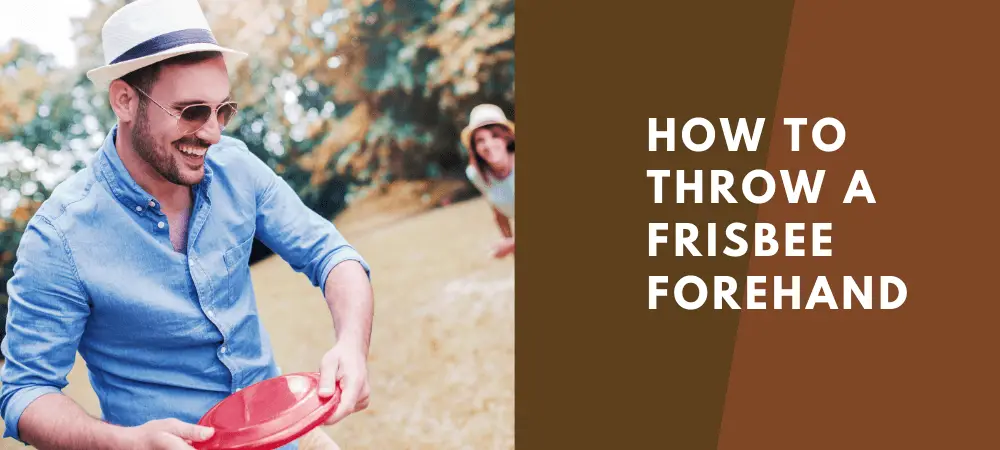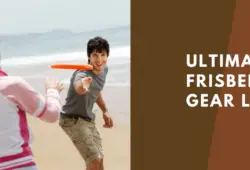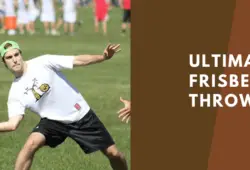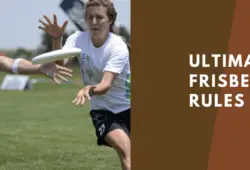In ultimate Frisbee, it’s common for players to use the flick or the forehand throw as it gives the defense a hard time.
So if you’re yet to master this essential skill, then you’re missing out big time.
But no need to worry. In today’s article, we are taking you through the process of throwing a Frisbee forehand.
Read through to the end for some amazing insights;
Table of Contents
Steps to Throw a Frisbee Forehand
-
Ready Your Wrist
In forehand throwing, it’s your wrist that’s going to do most of the work.
Therefore, you have to get it into shape and prepare for the upcoming task. And that calls for a little practice.
As you sit or stand (whichever you prefer), lift your arm and reach out to an invisible door, right above you.
Next, let your arm assume an L- position and try turning the imaginary doorknob.
Do this a few more times and take time to rest, before repeating again until you master this concept.
As you do this, you will realize that it’s your arm that’s moving a lot and not your entire arm. That’s how a forehand throw should naturally feel.
All the disc spins will depend on your wrist speed.
-
The Grip
Like the backhand, there are various types of forehand grips.
- Split Finger
This is an ideal pick if you want to achieve a more accurate and less powerful throw.
First, work on forming a “v” by placing both your index and middle fingers under the disc, such that they are both tight against the rim and the index finger points towards the middle.
Next, place your thumb on the front side of the disc, a little bit further from the rim.
The remaining fingers should loosen in your palm.
Ensure you’re comfortable.
- Power grip
This Frisbee grip is meant to give you more power. And because of the complexity that comes with it, you need to practice some more to achieve accuracy.
The steps are similar to the ones of the split-finger (above), only that this time around, your index finger should slide next to the middle finger to achieve a “pointing-gun” position.
Check out the following video on how to achieve the right grip;
-
Body Position
Ensure to position yourself upright facing the endzone.
Take a position on your feet balls with your knees bent and legs apart at equal length with your shoulders.
Also, ensure that the elbow of your throwing arm remains closely by your side, disc in hand.
-
Execution
Now hold the disc properly and get ready to throw.
It should be around shoulder height and parallel to the ground.
Practice the wrist motion you learned earlier and this time around, let your wrist move as far back as possible.
And then in a quick motion, release it forward and let go of the disc, such that it flings off your fingers and straight ahead.
The disc should fall at around 10-20 feet from your standing position.
Remember, you can always adjust the height to suit your comfortability, especially after you’ve mastered the concept.
-
Experimentation
People are different and so are Frisbee throwers.
So we can’t just assume that everyone is of the same height and body size.
That’s why self-experimentation is extremely vital to help you discover your comfort zone.
For instance, if the above steps don’t seem to work well with you, then you can adjust your grip or the movements of your wrist to see if you can achieve more.
Another way is by setting a target for each throw and keeping a mental note of the changes that work for you.
That way you get to apply them several times until you achieve your goal.
Some players do better with a little or more arm movement.
Remember it’s all about power. Get it and flick your way into winning!
-
Replication
Remember great things don’t come easy. So most probably your first flick is going to be a disappointment.
But don’t lose hope, it will get better with every throw.
Trial and error is the way to go. And by the time you clock 200or so throws, you would have made a noticeable improvement.
You can measure this by the ease of throwing, accuracy, power variations and of course ease of muscle movements.
By the time you get to 1000 and way above 2000 throws, you can now randomly pick a disc, throw it and hit the target!
So you see, the secret is repetition. Use the forehand throw as much as you can.
And above all, patient pays.
It might not seem like it at the beginning, but you will begin to reap fruits within no time.
The video below will help you understand the dos and don’ts;
Tips on How to Improve your Frisbee Forehand Throw
1.Always stretch properly before you throw
2. Before releasing a disc, ensure you have a good grip and it should always be parallel with the ground.
3. Work on improving your release time by practicing trial and error.
For instance, the disc shouldn’t land far left or far right. This also applies to working on your body angle.
4. Ensure the disc flings off your fingers to avoid disc wobbles.
As a beginner, be ready to deal with this, but it should fade off with time as you learn the art of wrist flexibility.
The best way to achieve this is to keep practicing. Most wobbles are a result of poor disc grip or the disc simply refuses to spin when you release.
5. Take time to practice the doorknob technique to help you achieve easy disc spins and throw momentum.
So don’t be afraid to lock that arm and elbow and get turning that imaginary doorknob wherever you’re.
Conclusion
Forehand Frisbee throws are important skills for every ultimate player.
This is because, when a player knows how to achieve both forehand and backhand throws, they’re usually in a great position to choose the options they prefer at a given time.
Therefore, roll-up your sleeves, get practicing those imaginary doorknobs, master the grip and learn the art of body position.
They will help you achieve perfect execution, but of course with lots of experimentation, repetition, and patience.




